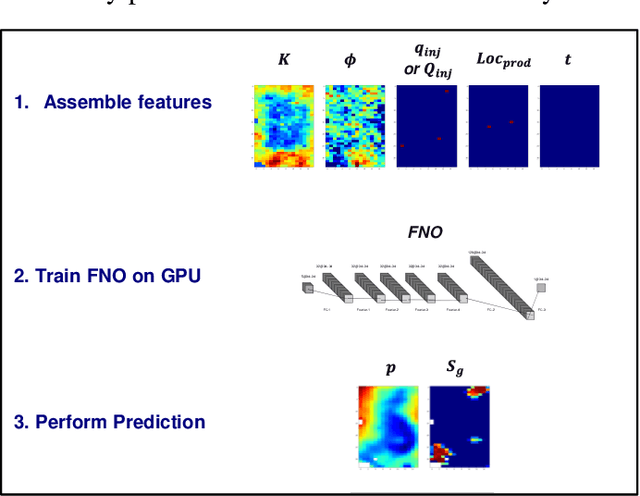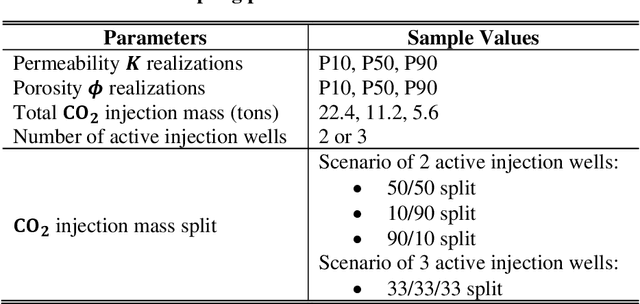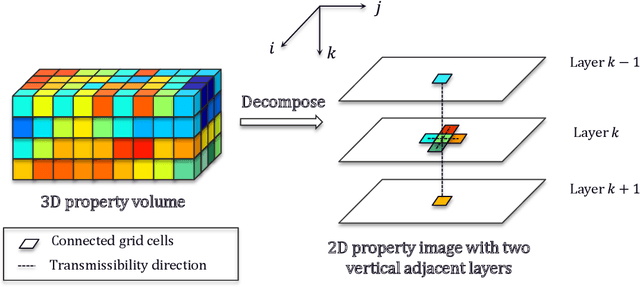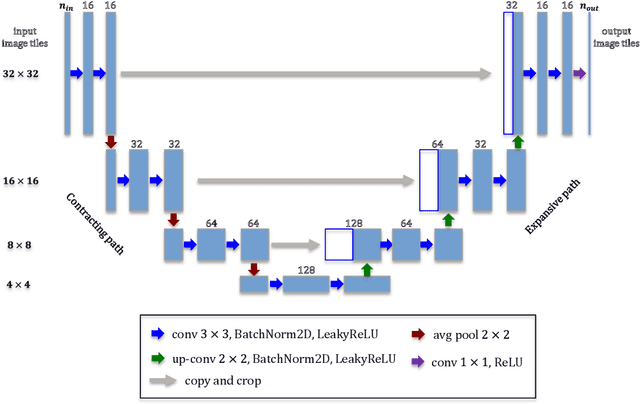Bailian Chen
A Robust Deep Learning Workflow to Predict Multiphase Flow Behavior during Geological CO2 Sequestration Injection and Post-Injection Periods
Jul 15, 2021



Abstract:This paper contributes to the development and evaluation of a deep learning workflow that accurately and efficiently predicts the temporal-spatial evolution of pressure and CO2 plumes during injection and post-injection periods of geologic CO2 sequestration (GCS) operations. Based on a Fourier Neuron Operator, the deep learning workflow takes input variables or features including rock properties, well operational controls and time steps, and predicts the state variables of pressure and CO2 saturation. To further improve the predictive fidelity, separate deep learning models are trained for CO2 injection and post-injection periods due the difference in primary driving force of fluid flow and transport during these two phases. We also explore different combinations of features to predict the state variables. We use a realistic example of CO2 injection and storage in a 3D heterogeneous saline aquifer, and apply the deep learning workflow that is trained from physics-based simulation data and emulate the physics process. Through this numerical experiment, we demonstrate that using two separate deep learning models to distinguish post-injection from injection period generates the most accurate prediction of pressure, and a single deep learning model of the whole GCS process including the cumulative injection volume of CO2 as a deep learning feature, leads to the most accurate prediction of CO2 saturation. For the post-injection period, it is key to use cumulative CO2 injection volume to inform the deep learning models about the total carbon storage when predicting either pressure or saturation. The deep learning workflow not only provides high predictive fidelity across temporal and spatial scales, but also offers a speedup of 250 times compared to full physics reservoir simulation, and thus will be a significant predictive tool for engineers to manage the long term process of GCS.
Improving Deep Learning Performance for Predicting Large-Scale Porous-Media Flow through Feature Coarsening
May 08, 2021



Abstract:Physics-based simulation for fluid flow in porous media is a computational technology to predict the temporal-spatial evolution of state variables (e.g. pressure) in porous media, and usually requires high computational expense due to its nonlinearity and the scale of the study domain. This letter describes a deep learning (DL) workflow to predict the pressure evolution as fluid flows in large-scale 3D heterogeneous porous media. In particular, we apply feature coarsening technique to extract the most representative information and perform the training and prediction of DL at the coarse scale, and further recover the resolution at the fine scale by 2D piecewise cubic interpolation. We validate the DL approach that is trained from physics-based simulation data to predict pressure field in a field-scale 3D geologic CO_2 storage reservoir. We evaluate the impact of feature coarsening on DL performance, and observe that the feature coarsening can not only decrease training time by >74% and reduce memory consumption by >75%, but also maintains temporal error <1.5%. Besides, the DL workflow provides predictive efficiency with ~1400 times speedup compared to physics-based simulation.
A Physics-Constrained Deep Learning Model for Simulating Multiphase Flow in 3D Heterogeneous Porous Media
Apr 30, 2021



Abstract:In this work, an efficient physics-constrained deep learning model is developed for solving multiphase flow in 3D heterogeneous porous media. The model fully leverages the spatial topology predictive capability of convolutional neural networks, and is coupled with an efficient continuity-based smoother to predict flow responses that need spatial continuity. Furthermore, the transient regions are penalized to steer the training process such that the model can accurately capture flow in these regions. The model takes inputs including properties of porous media, fluid properties and well controls, and predicts the temporal-spatial evolution of the state variables (pressure and saturation). While maintaining the continuity of fluid flow, the 3D spatial domain is decomposed into 2D images for reducing training cost, and the decomposition results in an increased number of training data samples and better training efficiency. Additionally, a surrogate model is separately constructed as a postprocessor to calculate well flow rate based on the predictions of state variables from the deep learning model. We use the example of CO2 injection into saline aquifers, and apply the physics-constrained deep learning model that is trained from physics-based simulation data and emulates the physics process. The model performs prediction with a speedup of ~1400 times compared to physics-based simulations, and the average temporal errors of predicted pressure and saturation plumes are 0.27% and 0.099% respectively. Furthermore, water production rate is efficiently predicted by a surrogate model for well flow rate, with a mean error less than 5%. Therefore, with its unique scheme to cope with the fidelity in fluid flow in porous media, the physics-constrained deep learning model can become an efficient predictive model for computationally demanding inverse problems or other coupled processes.
 Add to Chrome
Add to Chrome Add to Firefox
Add to Firefox Add to Edge
Add to Edge